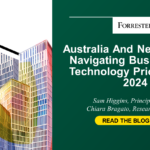Great Teams Move Fast And Stay Connected, But How?
Config 2024 — Figma’s annual user conference — was a sight to behold this year. The Moscone Center in San Francisco was nearly bursting at the seams with energy … and people. Registered attendees clocked in at approximately 10,000, selling out the event. I found the buzz of new ideas, like minds, and organized chaos to be a delightfully energizing experience. Graciously, my Figma hosts made sure to create space for this Forrester analyst to connect with Figma leaders in product, research, design, and development disciplines. These leaders candidly spoke from the stage and were equally candid with me one on one as we discussed where it’s all going … and how it’s going.
As an analyst, I spend a lot of time talking to clients about how to work cross-functionally, something Figma not only does well but has built a business on. It’s challenging for most of us to create focus or to be productive as individuals, let alone as teams or at scale! During this year’s Config, I wanted to rise above the AI chatter to learn how the rapid pace of discovering what AI can do today (that it quite literally could not do yesterday) and launching new products and capabilities is impacting Figma leaders’ perspectives on how they tend to their teams of talented humans.
Pardon me if this piece feels a little bit gushy, but teamwork, reflective leadership, and a willingness to admit that you don’t have it all figured out are rare in companies today. It seems Figma leaders are doing their best to bring a level of introspection to their work that supports a rewrite of the blustering, know-it-all rhetoric that leads to subpar and sometimes harmful products and experiences. While we can’t see everything that goes on in companies as analysts, we can “see” a lot by observing how their leaders collaborate among themselves. The Figma leadership clearly spends time together and, most of all, respects each other and other colleagues. Get inspired with these insights from Figma leaders.
Dylan Field — Co-Founder & CEO
“Which of your company values have been tested the most during this time of rapid growth?”
Field shared that Figma revisited its initial values (“foster inclusivity, be bold, and have fun”) a few years ago, and he’s glad they did. While the core intent of the first three live on in Figma’s current values, one of the newer additions, “run with it,” has been tested and promoted the most. The company could have taken the path of tight control and strict governance of what teams were allowed to work on, but leaders wisely understood the need for employees to maintain autonomy. Field said, “People need to feel empowered to still deliver things that don’t come from the top. I’ve also been thinking a lot about ‘play’ (the successor to ‘have fun’ in the values lineup). We need levity when things are hard.”
Avantika Gomes — Group Product Manager, Design Systems, Prototyping, & Developer Tools
“How do you organize your teams for success?”
Gomes explained that there are many ways to organize your teams (e.g., features, functions, journeys, etc.), but she’s found the most success in organizing teams around problems that must be solved for users — for example, “help developers become more productive” and “increase collaboration between design and development.” Organizing her diverse teams (design systems, prototyping, and developer tools) around problems to solve allows them to see the interconnectedness of their shared opportunities.
She added that, for teams to tackle these clearly defined problems successfully, she avoids giving dictates by asking herself, “How do I decentralize [power, decisions, etc.]?” Gomes prefers to lead from the side by working with her teams instead of leading from the front or from behind. Together, these teams are empowered to test and learn from users at a rapid pace and are better able to avoid the barriers leaders sometimes cement when they fail to push work down to the level of the team.
Kris Rasmussen — Chief Technology Officer
Thoughts on craftsmanship
A common theme during Config 2024 was craft. The idea of craft is often associated with the design profession and the idea of quality that comes from thoughtfulness and expertise. I was delighted to hear Rasmussen’s take on craftsmanship, which is overtly counter to the behaviors I see too often in many firms today. He believes that craftsmanship is at the core of everything Figma does. He said, “I want engineers who love the craft and art of engineering just as much as designers care about their craft. Craft, taste, and judgment are really important in the exploration of what’s possible.”
Craft requires expertise, iteration, time, thoughtfulness, and in the face of complicated technological goals, collaboration and challenge. “Love your craft” is also Figma’s third value. To care about craft is to care about how what you make will be used by others. When was the last time you challenged your immediate and cross-functional teammates to reflect on your craft?
Anna Kohnen — Director of Business Development & Partnerships
“How is Figma thinking about the criteria for partnerships?”
Kohnen’s response to this question revealed her take on how Figma’s values play out in her world. She shared that “building community is important,” especially as they build the partner community. The Figma value “grow as you go” is front and center in importance as they develop the firm, partnerships, and relationships with the multiple types of customers Figma has today.
Listening is central to creating quality experiences, but knowing your unique differentiating value, and when to build, buy, or partner to expand capabilities, is an ongoing conversation that the Figma leadership takes seriously. Kohnen’s opinion was that “we hear a lot about what customers want and need as they do their work — we hear that, but we don’t think we have to do that work just because customers ask.” You might wonder what Kohnen’s intent was in making this statement. She elaborated and explained that providing what customers need sometimes requires the right partner, not a Figma-built solution, especially when there are partners that can provide a better solution. Being clear about why and when Figma builds or partners keeps Figma leaders and employees focused on a clear path.
Shamil Turner — Manager, Enterprise Solutions Architects
Thoughts on bridging the gap between design and development
Lastly, but maybe more so firstly, Turner and I were able to discuss Figma’s journey to better connect designer and developer workflows. Turner says, “Figma’s background in engineering, not just design, is what is helping us sell Figma into IT shops.” With consultants worldwide, he can deploy his team to help design and development teams have conversations that they perhaps haven’t had before.
Turner says that “transparency is the way we work.” This operating norm is helping Figma customers embrace new paradigms for collaboration, not just new technologies (although the tech is certainly helping). Two out of every three Figma users are not designers. Turner knows this firsthand as the leader of an active “boots on the ground” team that is growing.
Get In Touch
If you want to hear other Forrester analysts’ takes on what happened at Config, check out recent blog posts from my colleagues Gina Bhawalkar and David Truog.
Forrester Client?
If you’re a Forrester client and would like to dive deeper into any of the topics discussed above, set up a conversation with me.
Vendor Or Provider?
If your company is a design software provider and you’d like to tell me about your latest and greatest, feel free to submit a briefing request.
Just Want To Follow, Share, Or Learn?
You can also follow or connect with me on LinkedIn, especially if you’d like to share your experiences using design software for your organization and are willing for me to interview you.








